The Quest For The Cheap Laptop - Don’t count the Mac Out Entirely
Wednesday, August 1, 2007
by Charles W. Moore
There are plenty of laptop computers these days in the sub-$1,000 range, but Apple isn’t among them, not even marginally so as it was in the past with the $999 entry-level iBook.
On the other hand, Dell offers a variety of sub-$1,000 laptops, beginning with the Inspiron 1501 at $499.00, Lenovo has its ThinkPad 3000 Series of price-leader models beginning at $699.00, with a Core 2 Duo ThinkPad R currently offered at $800.00, and that’s just two of the top name brands before reseller discounting (see LaptopQuotes.com).
WalMart will currently sell you an Everex NC1502 15.4” laptop for a list price of $478.00, and has the Acer Aspire 3680 on special for $449.00. With the cheapest MacBook starting at $1,099.00, Apple isn’t even in the low-end game.
However, even $450 is nowhere near the floor when it comes to laptop computer pricing.
Adv: Compare MacBook prices & bundles at Mac Prices. Listings updated daily - over 3 million readers served.
While Nicholas Negroponte’s “One Laptop Per Child” (OLPC) initiative is strongly focused on putting inexpensive laptops in the hands of schoolchildren throughout the developing world, he has indicated that his organization would not be averse to selling computers to the general public if supplies permit to help subsidize the charitable effort with economy of scale.
In mid-July OLPC announced that Intel is coming on board as a supporter, and then on the 23rd, Mr. Negroponte announced in Geneva, Switzerland, that a retail version of the OLPC’s XO computer could be available as early as September 2007. Te XO laptop’s selling price is expected to be in the neighborhood of $350.00, roughly twice its production cost, although $525.00 is also reportedly being considered as the price point. The XO will be manufactured by Quanta in Taiwan - the same outfit that builds MacBook Pros for Apple.

In terms of appearance, the XO, incidentally looks like it owes more than a little inspiration to Apple’s original clamshell iBook (although internal engineering-wise it has more in common conceptually the Apple Newton eMate 300 of 1997-’98), with its integral carry-handle, bright green white color scheme (remember the Key Lime iBook)?), and rounded contours. The XO’s distinctive appearance is part of the design strategy, first strongly appeal to XO’s primary intended users; but also to discourage gray-market traffic.
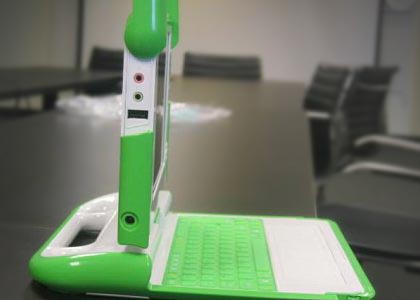
With its “transformer” hinge, the XO can assume several configurations: standard laptop form factor, e-book reading, and gaming.
Anticipating rough-usage in harsh environments, the XO has a sealed, rubber-membrane keyboard, and there is an innovative, dual-mode, extra-wide touchpad that supports drawing and writing as well as basic pointing.
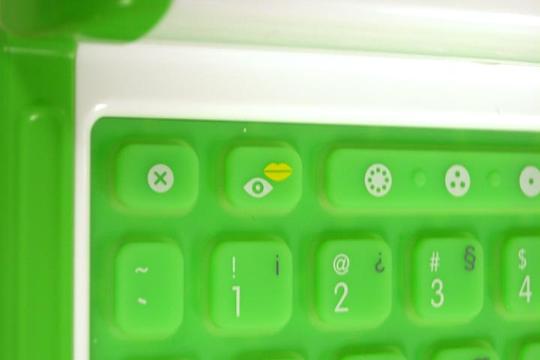
The XO is “green” in more than color and contains no hazardous materials, its NiMH batteries contain no toxic heavy metals, and it features enhanced battery management for an extended recharge-cycle lifetime, and will tolerate alternate power-charging sources, such as car batteries.
In addition, for use when external power is not available, the XO can be hand powerable by at least two of three options: a crank, a pedal, or a pull-cord.
The XO will use the Sugar graphical user interface, written in Python, on top of the X Window System and the Matchbox window manager. Apple’s Steve Jobs offered OLPC the Mac OS X operating system free of charge for use in the XO, but reportedly the designers wanted an operating system that can be tinkered with and turned down OS X because it’ not open source in favor of Linux.
To enhance ruggedness and reliability, the XO has no hard drive and only two internal cables. There are also no optical drives, no floppy drives, no cooling fans, no ATA interface is unnecessary due to the lack of hard drive, and there is also no PC Card slot either, although an SD slot will be available. Storage memory will be a 1 GB NAND flash drive with 256 MB of RAM. For added robustness, the machine’s plastic walls are 2mm thick, as opposed to the standard 1.3mm. Its mesh network antennas (the distinctive “ears”), which far outperform the typical laptop, double as external covers for the USB ports, which are protected internally as well. The display is also cushioned by internal “bumpers.”
For added robustness, the plastic case’s walls are 2mm thick, as opposed to the standard 1.3mm. Its mesh network antennas outperform the typical laptop for wireless range and double as external covers for the USB ports, which are protected internally as well. The display is cushioned by internal “bumpers.”
The XO laptop is pretty cool, and should be eminently well-suited for its intended purpose, although it would be compromised too much for general purpose computing.
eWeek’s Jim Rapoza has posted a very thorough review of the XO, and notes:
Put simply, the XO is one of the most revolutionary computer systems that I’ve seen in some time. The entire time I was looking at the XO, I was thinking, why can’t my new expensive laptop do this? The technologies that the OLPC’s XO are introducing could go a long way towards changing the face of future systems, especially in the area of power consumption.
For the full review visit here:
http://etech.eweek.com/content/desktops_and_notebooks/meet_the_xo.html
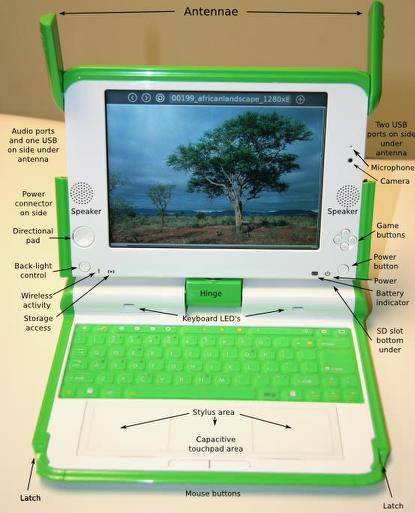
OLPC XO laptop specs:
Internals
Processor: AMD Geode LX-700@0.8W
CPU clock speed: 433 Mhz
Compatibility: Athlon instruction set (including MMX and 3DNow! Enhanced) with additional Geode-specific instructions (X86/X87-compatible)
North Bridge: PCI and Memory Interface integrated with Geode CPU
Chipset: AMD CS5536 South Bridge
Graphics controller: Integrated with Geode CPU; unified memory architecture
Embedded controller (for production), ENE KB3700
DRAM memory: 256 MiB dynamic RAM
Data rate: Dual — DDR333 — 166 Mhz
Mass storage: 1024 MiB SLC NAND flash, high-speed flash controller
Display:
Liquid-crystal display: 7.5” Dual-mode TFT display
Viewing area: 152.4 mm * 114.3 mm
Resolution: 1200 (H) * 900 (V) resolution (200 DPI)
Mono display: High-resolution, reflective monochrome mode
Color display: Standard-resolution, quincunx-sampled, transmissive color mode
Special “DCON” chip, that enables deswizzling and anti-aliasing in color mode, while enabling the display to remain live with the processor suspended.
Integrated peripherals:
Keyboard: 70+ keys, 1.2mm stroke; sealed rubber-membrane key-switch assembly
Keyboard layout details
Keyboard layout pictures - international, Thai, Arabic, Spanish, Portuguese, West Africa, Urdu, French
Cursor-control keys: five-key cursor-control pad; four directional keys plus Enter
Touchpad: Dual capacitance/resistive touchpad; supports written-input mode
Audio: Analog Devices AD1888, AC97-compatible audio codec; stereo, with dual internal speakers; monophonic, with internal microphone and using the Analog Devices SSM2211 for audio amplification
Wireless: Marvell Libertas 88W8388+88W8015, 802.11b/g compatible; dual adjustable, rotating coaxial antennas; supports diversity reception
Status indicators: Power, battery, WiFi; visible lid open or closed
Video camera: 640*480 resolution, 30FPS
External connectors:
Power: 2-pin DC-input, 10 to 20 V usable, –50 to 39 V safe, one-time fuse for excessive input
Line output: Standard 3.5mm 3-pin switched stereo audio jack
Microphone: Standard 3.5mm 2-pin switched mono microphone jack; selectable sensor-input mode
Expansion: 3 Type-A USB-2.0 connectors; MMC/SD Card slot
Battery:
Pack type: 4 or 5 Cells, 6V series configuration
Fully-enclosed “hard” case; user removable
Capacity: 22.8 Watt-hours
Cell type: NiMH (or LiFeP)
For more information, visit:
http://laptop.org/
Even cheaper (indeed less than half) the projected retail price of the OLPC XO is the Medison Celebrity, another Linux-based jobbie, this time from Sweden of all places.
That is, if it’s for real. Apparently none have actually shipped yet, and there is some conjecture and controversy as to whether the whole thing might be an elaborate hoax.
If the Medison Celebrity is the real deal, however (I’m still in wait-and-see mode on that) it would be an impressive, even unbelievable value for $150.00.
The Linux version that comes with the laptop is Fedora from RedHat, but you can run Windows as well if you buy a copy.
Key advertised Features
Intel Celeron 1.5 GHz CPU
14” Widescreen X-bright LCD
256 MB RAM memory
40 GB Hard Drive
802.11g Wireless LAN
Optimized Linux operating system
Pre-installed office and multimedia applications
Selected Technical Specifications
CPU - Intel Celeron M Processor 370 (1.5 GHz, 90nm, FSB400, 1 MB L2 cache, uPGA478)
Display - 14.0” WXGA (1280x768) TFT
Hard Drive - 40 GB
Dimensions - 333(W) x 243(D) x 24/33.(H)mm (front/back)
Weight - 2.2Kg with 6 cells Lithium-lion battery
Memory - 64-bit wide DDR data channel, One 200-pin SODIMM socket, supporting DDR 333/400, 256 MB Expandable up to 1GB, based on SODIMM Modules
Storage - One changeable 2.5” 9.5mm(H) HDD, Supporting Master mode IDE ATA-33/66/100/133 (Ultra DMA)
One changeable 12.7mm(H) CD/DVD Combo
Video Controller - VIA PN800 integration, Shared Memory Architecture up to 64MB, 128 bit 3D graphic engine, Support analog monitor pixel resolution up to 1920x1400, Supports two displays dual view
Keyboard - A4 size keyboard, Built-in Touchpad with scrolling function
Sound System - AC’97 2.2 Compliant Interface, 3D stereo enhanced sound system, Sound-Blaster PROTM Compatible, S/PDIF Digital output (5.1 CH), 1x Built-in Microphone, 2x Built-in Speakers
I/O Ports - 3x USB 2.0 ports, 1x External CRT monitor output, 1x Headphone jack, 1x Microphone jack, 1x S/PDIF output jack, 1x RJ-45 port for LAN, 1x Line-in jack, 1x DC-In jack
PCMCIA - 1x Type II PCMCIA socket
Communication - 10/100BASE-TX Fast Ethernet on board, 802.11g MiniPCI Wireless LAN
Power - Full Range 65W AC adapter - AC input 100~240V, 47~63Hz, DC output 20V, 3.25A, Removable 6-cell Smart Li-ion battery pack, 4000/4400mAh
security - Kensington Lock
Sounds too good to be true for 150 bucks. The developers explain that they think everyone should be able to afford to have a laptop, and calim that they can sell at the lowball price because they have their own plants where they assemble their laptops. That’s all very nice, but you still have to buy components for which there is a floor market price.
The Medison Celebrity laptop is advertised selling for $150.00 USD
For more information, visit:
http://www.medisoncelebrity.com/product.html
ZNet’s Larry Dignan has ordered one, and you can read his thoughts at:
http://blogs.zdnet.com/BTL/?p=5746
and
http://blogs.zdnet.com/BTL/?p=5789
For a response to the hoax allegations, see:
http://www.2checkout.com/community/support/topic.php?id=214&page&replies=4#post-717
So where does the Mac fit into all this? Well, with due respect to Nicholas Negroponte, I think he made a mistake turning down Steve Jobs’ OS X offer. The iPhone proves that OS X can run nicely on minimalist (so to speak) devices, and it has a lot more developed potential and elegance than Linux with Sugar on top.
I have long maintained that the ideal cheap laptop is a used or refurbished PowerBook or iBook, and even Apple Certified Refurbished Core 2 Duo MacBooks are available well below the psychological $1,000 threshold, complete with a full Apple Warranty and eligibility for AppleCare coverage. I’ve been more than satisfied, indeed delighted, with the performance of my Apple Certified Refurbished 17” PowerBook purchased 18 months ago.
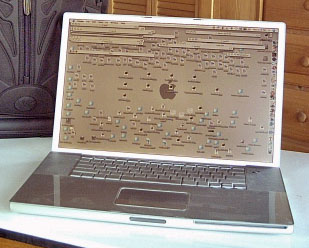
However, even at the low end of low end, I think there’s a strong case to be made for a used PowerBook or iBook. The Pismo PowerBook I’m typing this article on right now was purchased a couple of months ago for about $300, and it has lots of productivity left in it - indeed appears to be in near-new condition.

The price of 500 MHz - 600 MHz G3 dual USB iBooks is now in the $200 range, with 700 MHz machines going for about $100 more than that, and these are all computers that can serve quite nicely as general use machines so long as you’re not heavily into graphics or video editing or serious gaming. They will all run OS X 10.4 Tiger, which is pretty amazing for a $200 laptop.
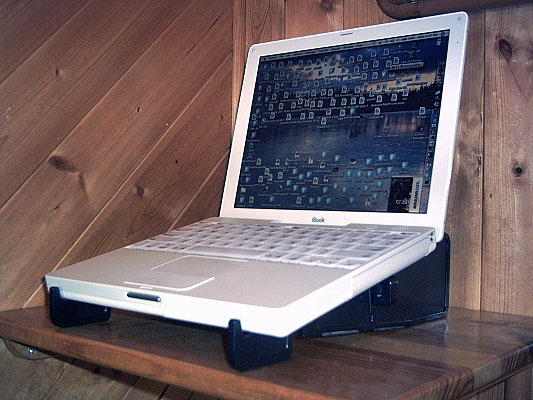
I have a 700 MHz G3 iBook, and OS 10.4.9 runs beautifully on it, with lively Finder response, and I can still do about 95% of what I do with computers on this machine without feeling significantly compromised, and that goes for running dictation software, scanning, and image editing with Photoshop Elements 4.0.
And of course there are a whole raft of faster G3 and G4 dual USB iBooks available on what is a buyers’ used market, all pretty much priced below $600 - perhaps a bit more for a 1.42 GHz G4 unit.
And if you’re smitten with some of the OLPC XO’s features like the handle, bright colors, and extra-rugged case construction, one of the original clamshell, iBooks can still serve as a pretty capable computer, especially the last-generation 366 MHz and 466 MHz FireWire “Paris” models, which are officially supported by OS 10.4 Tiger. The PowerBook Guy even has some Key Lime 366 MHz units available at this writing for $289.95, plus 300 MHz models for $169.95 (supported by OS 10.3 Panther). You can check it out at:
http://www.powerbookguy.com/xcart/catalog/index.html
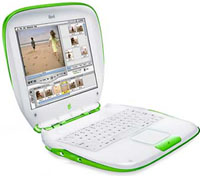
And if you fancy a bit of history and Apple’s decade-ahead-of-its-time take on the minimalist laptop, CustomMacs has some Apple Emate 300’ offered at $89.99. You can check it out at: http://www.custommacs.com/store.html
The eMate wasn’t a Mac - it used Apple’s Newton 2.1 OS - but it had a laptop form factor, and featured a 25 MHz ARM 710a processor, 8 MB of ROM, 3 MB of RAM (1MB of DRAM, 2 MB of Flash Memory for user storage), a PCMCIA slot, and IrDA-beaming capabilities, and and standard Macintosh serial/LocalTalk ports.
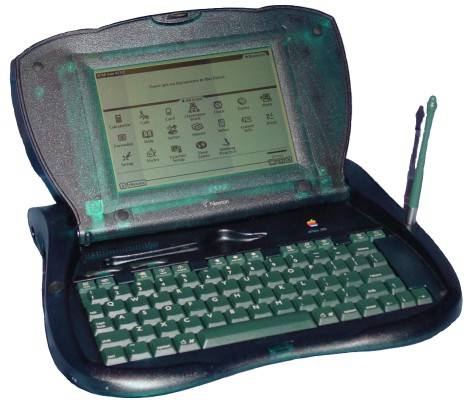
The eMate 300 was packaged in a funky-styled and super-rugged translucent aquamarine and black clamshell case (stylistic resonances of which lived on in the original clamshell iBooks) with a 480x320 16-shade grayscale backlit LCD touchscreen display that could be used either Newton PDA style with a stylus or laptop-style with a built-in conventional keyboard, and came bundled with a suite of built-in software applications including a word processor, draw program, spreadsheet, graphing calculator, address book, calendar functions, and more. It could also run hundreds of applications that had been developed for Newton 2.0.
The eMate 300 also had TCP/IP capabilities for Internet and email access. A very cool characteristic of the eMate was that it could provide up to 24 hours of continuous use without recharging, depending on usage, according to Apple.
Measuring 12.0” x 11.4” x 2.1” and weighing in at four pounds, the eMate 300 was heavier than the rumored MacBook Pro subnotebook is anticipated to be if and when it materializes, and the eMate was lighter, but not smaller than either the contemporaneous subnotebook PowerBook Duos and PowerBook 2400s, or the 12” PowerBooks and iBooks that followed. The eMate was, however, a lot cheaper than any PowerBook available at the time, selling for US$800.00, although that price would put it in the high end of the low end today.
Note: Letters to PowerBook Mystique Mailbag may or may not be published at the editor's discretion. Correspondents' email addresses will NOT be published unless the correspondent specifically requests publication. Letters may be edited for length and/or context.
Opinions expressed in postings to PowerBook Mystique MailBag are owned by the respective correspondents and not necessarily shared or endorsed by the Editor and/or PowerBook Central management.
If you would prefer that your message not appear in PowerBook Mystique Mailbag, we would still like to hear from you. Just clearly mark your message "NOT FOR PUBLICATION," and it will not be published.
CM